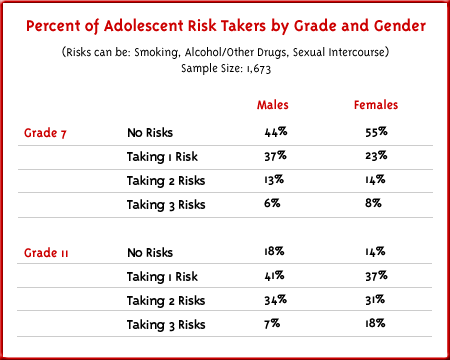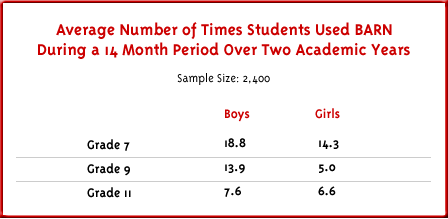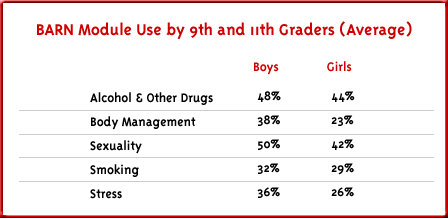
Summary
of the Body Awareness Resource Network (BARN) Evaluation Study
Table of Contents
The
Problem
Chart: Percent of Adolescent Risk
Takers by Grade and Gender
The Initial Challenge
The Evaluation
Chart:
Average Student Use of BARN During a 14 month period
Chart: BARN Module Use by 7th Graders
Chart: BARN Module Use by 9th and 11th Graders
Key Significant Findings
The Future
The Problem
When they were teenagers, many of today's adults took a drink to learn
about alcohol, took a puff to learn about tobacco and/or marijuana, gossiped,
read forbidden novels, or experimented to learn about sex. Many lucky
teens passed into adulthood unscathed. Others made mistakes that led to
addiction, unwanted pregnancy, or health-related misfortunes.
Today's teenagers face the same risk their parents faced—and more.
Hard drugs, lethal diseases, and stressful day-to-day living threatens
to overwhelm today's adolescents. The path to adulthood in the new millennium
can be rocky indeed.
The Chart
below illustrates the extent of teenage risk-taking measured by the BARN
program's survey.

The
Initial Challenge
The initial challenge of the BARN interactive software development project
was to bring teenagers facing new health-related risks together with relevant
facts and prevention strategies to positively affect behaviors.
Clearly, communication about health with adolescents might help, avoid,
or delay some risky or life-threatening behaviors. Even a single fact
or strategy, available at the right time, might make a difference. Yet
it's hard, especially for teenagers, to approach adults about sensitive
topics. For those who make mistakes, information is more available. Crisis-oriented
health and social service agencies offer experts and other resources.
Unfortunately, the information usually comes only after the mistake is
made. But what about the majority of teens—at risk but without access
to comprehensive health education resources? Could a computer-based health
system be an answer?
Over the next six years, the BARN software system (topics include: Alcohol
and Other Drugs, Body Management, HIV/AIDS, Human Sexuality, Smoking,
and Stress Management) evolved at the University of Wisconsin-Madison
with funding from the Kellogg Foundation.
The
Evaluation
BARN was evaluated at school sites in Milwaukee, Wisconsin (6 sites);
Oakland, California (2 sites); Watsonville, California (2 sites); South
Bronx, New York (4 sites); Brooklyn, New York (4 sites); rural Wisconsin
(2 sites) and rural North Carolina (3 sites). Students of diverse economic
and social backgrounds used the system.
During the study, 6,000 students participated. Students were first introduced
to the BARN software in a structured setting. The software was then placed
in a convenient, private location where students could access it on their
own. The software tracked by student the number of uses of each software
module. This information was used with information from a 360 question
survey that was administered as a pre-test, post-test, and follow-up.
The survey measured student's health knowledge, attitudes, and behaviors.
Other questions covered intervening variables such as peer pressure, family
communication, self-confidence, mental health and values. The survey collected
demographic data such as gender and age.



Using the survey information and the information from tracking BARN's use researchers were able to determine the impact BARN had on teen behaviors.
Key
Significant Findings
- BARN was used by students who needed it most. Students already taking
the most health risks were also more likely to use BARN than those who
weren't.
- More importantly, risk-taking students used BARN modules relevant to
the particular risks they were taking.
- BARN slowed the progress of risk-taking behaviors and lead to fewer
problematic risks.
- Contrary to traditional health information and education approaches
that often reach the people who least need the information, BARN consistently
reached students who were more likely to have undertaken a variety of
risk behaviors. It is clear that BARN's information and behavioral change
strategies reached teens with the greatest need—BARN works.
The
Future
A new version of BARN has recently been developed that adds multimedia
elements to the traditional BARN system. The new multimedia edition is
attractive to today's teen and permits the use of BARN by individuals
and small groups, and with the use of a projection devise by large groups.
These advances in BARN technology are being funded by the National Cancer
Institute and the National Institute on Drug Abuse. Currently, a new study
is in progress that is designed to evaluate the impact of multimedia.
©2012 Learning Multi-Systems, Inc. | 1-800-362-7323